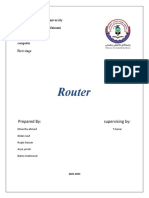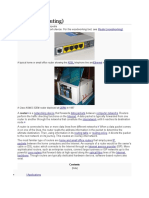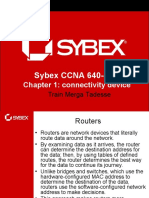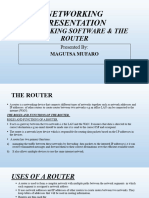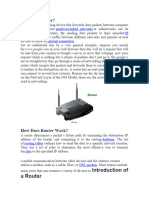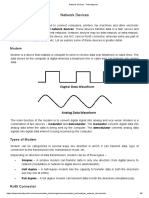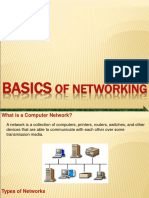ROUTER
A Router is a networking device that forwards data packets between computer networks. One
or more packet-switched networks or subnetworks can be connected using a router. By
sending data packets to their intended IP addresses, it manages traffic between different
networks and permits several devices to share an Internet connection.
WORKING
A router determines a packet’s future path by examining the destination IP address of
the header and comparing it to the routing database. The list of routing tables outlines
how to send the data to a specific network location. They use a set of rules to
determine the most effective way to transmit the data to the specified IP address.
To enable communication between other devices and the internet, routers utilize a
modem, such as a cable, fibre, or DSL modem. Most routers include many ports that
can connect a variety of devices to the internet simultaneously. In order to decide
where to deliver data and where traffic is coming from, it needs routing tables.
A routing table primarily specifies the router’s default path. As a result, it might not
determine the optimum path to forward the data for a particular packet. For instance,
the office router directs all networks to its internet service provider through a single
default channel.
Static and dynamic tables come in two varieties in the router. The dynamic
routing tables are automatically updated by dynamic routers based on network
activity, whereas the static routing tables are configured manually.
� TYPES OF ROUTERS
There are several types of routers. Some of them are mentioned below:
1. Broadband Routers: These are one of the important kinds of routers. It is used to do
different types of things. it is used to connect computers or it is also used to connect to
the internet.
2. Wireless routers: These routers are used to create a wireless signal in your office or
home.
3. Wired Routers: Wired Router is used to connects multiple wired devices using a
Ethernet cable, It takes the transmission data from the modem and distribute it to a
further network, it is widely used in schools and small offices.
4. Edge Routers: As the name indicates, these are located at the edges usually
connected to an Internet Service Provider, and distribute packets across multiple
packets.
5. Core Routers: Core routers distribute packets within the same network. The main
task is to carry heavy data transfers.
6. Virtual Router: They are implemented using a software on the virtual machine , and
they are more flexible and scalable.
7. Portable Routers: They are used to create private Wi-Fi and hence designed for easy
portability.
� ADVANTAGES OF ROUTER
Easier Connection: Sharing a single network connection among numerous machines is
the main advantage of router. This enables numerous people to connect to the internet,
boosting total productivity. In addition, routers have connections between various
media and network designs.
Security: Undoubtedly, installing a router is the first step in securing a network
connection. Because using a modem to connect directly to the internet exposes your
computer to several security risks. So that the environment is somewhat secure,
routers can be utilized as an intermediary between two networks. While not a firewall
or antivirus replacement.
NAT Usage: Routers use Network Address Translation (NAT) to map multiple private
IP addresses into one public IP address. This allows for a better Internet connection
and information flow between all devices connected to the network.
Supports Dynamic Routing: The router employs dynamic routing strategies to aid in
network communication. The internet work’s optimum path is chosen
through dynamic routing. Additionally, it creates collision and broadcast domains.
Overall, this can lessen network traffic.
Filtering of Packets: Switching between packets and filtering packets are two more
router services. A collection of filtering rules are used by routers to filter the network.
The packets are either allowed or passed through.
DISADVANTAGES OF ROUTER
Slower: Routers analyze multiple layers of information, from the physical layer to
the network layer, which slows down connections. The same issue can also be
encountered when multiple devices are connected to these network devices, causing
“connection waiting”.
High Cost: They are more expensive than some other tools for systems
administration. This includes security, extension, and the focal point. As a result,
routers are typically not the greatest option for issues.
Need for configuration: The router must be properly configured to work properly. In
general, the more complex the intended use, the more configuration is required. This
requires professional installation, which can add to the cost of buying a router.
Quality Issues: The time transitions are not always accurate. Even yet, some modern
devices use the 2.4GHz band, which is frequently deactivated. These kinds of
separations are frequently possible for those who live in apartments and
condominiums.
Bandwidth shortages: Dynamic routing techniques used by routers to support
connections tend to cause network overhead, consuming a lot of bandwidth.
� LINE DRIVER
A line driver is an electronic device or circuit used to transmit signals over long
distances, typically in environments where signal degradation or noise could be an
issue. It amplifies or buffers the output signal to ensure it maintains its integrity and
strength over a long transmission line, like a cable or communication channel.
In simple terms, the line driver ensures that the signal can travel farther without losing
quality, making it essential in applications like:
1. Audio Systems: Ensures that audio signals can be sent over long cable lengths
without degradation.
2. Data Communication: Used to drive digital signals across long distances in
networks or other systems.
3. Video Systems: Helps maintain video signal quality over long cables, especially in
high-definition setups.
Line drivers typically use high-power amplification to provide a clean, strong output
signal, often designed to drive specific types of loads like differential pairs (in the
case of RS-485, for example).




